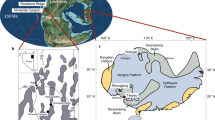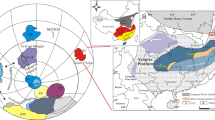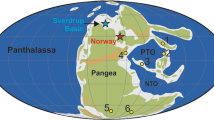Abstract
During the Eocene–Oligocene transition about 34 million years ago, permanent ice cover developed on Antarctica. This pronounced climate transition was accompanied by the deepening of the carbonate compensation depth in the oceans1 and perturbations in atmospheric carbon dioxide concentrations2,3. These changes may have been linked to continental weathering on Antarctica, but reconstructing which rock types were subject to weathering and the intensity of that weathering has proved challenging. Here we compare the lead (Pb) isotope values of seawater as recorded by extractions from decarbonated bulk sediments and those of silicate detrital fractions from deep-sea sediments from sites in the Southern Ocean that span the Eocene–Oligocene transition. These comparisons allowed us to assess local weathering inputs of Pb from Antarctica. The 206Pb/204Pb, 207Pb/204Pb and 208Pb/204Pb ratios suggest high rates of chemical weathering in the late Eocene, which would have helped draw down atmospheric CO2 to levels necessary for glacial initiation. Mechanical weathering and the introduction of newly exposed material was enhanced during the establishment of the Antarctic ice sheet. We also observe a divergence of seawater 206Pb/204Pb from detrital values during the Eocene–Oligocene transition, which implies an additional source of weathered material. We argue that the weathering of carbonate basement rock from Antarctica could explain the 206Pb/204Pb trend, and could have contributed to the observed deepening of the carbonate compensation depth through contributions to ocean alkalinity.
This is a preview of subscription content, access via your institution
Access options
Subscribe to this journal
Receive 12 print issues and online access
$259.00 per year
only $21.58 per issue
Buy this article
- Purchase on Springer Link
- Instant access to full article PDF
Prices may be subject to local taxes which are calculated during checkout


Similar content being viewed by others
References
Coxall, H. K., Wilson, P. A., Pälike, H., Lear, C. H. & Backman, J. Rapid stepwise onset of Antarctic glaciation and deeper calcite compensation in the Pacific Ocean. Nature 433, 53–57 (2005).
Pearson, P. N., Foster, G. L. & Wade, B. S. Atmospheric carbon dioxide through the Eocene–Oligocene climate transition. Nature 461, 1110–1113 (2009).
Pagani, M. et al. The role of carbon dioxide during the onset of Antarctic glaciation. Science 334, 1261–1264 (2011).
Erel, Y., Harlavan, Y. & Blum, J. D. Lead isotope systematics of granitoid weathering. Geochim. Cosmochim. Acta 58, 5299–5306 (1994).
Harlavan, Y., Erel, Y. & Blum, J. D. Systematic changes in lead isotopic composition with soil age in glacial granitic terrains. Geochim. Cosmochim. Acta 62, 33–46 (1998).
Von Blanckenburg, F. & Nägler, T. F. Weathering versus circulation-controlled changes in radiogenic isotope tracer composition of the Labrador Sea and North Atlantic deep water. Paleoceanography 16, 424–434 (2001).
Gutjahr, M. et al. Reliable extraction of a deepwater trace metal isotope signal from Fe–Mn oxyhydroxide coatings of marine sediments. Chem. Geol. 242, 351–370 (2007).
Basak, C., Martin, E. E. & Kamenov, G. D. Seawater Pb isotopes extracted from Cenozoic marine sediments. Chem. Geol. 286, 94–108 (2011).
Lear, C. H., Bailey, T. R., Pearson, P. N., Coxall, H. K. & Rosenthal, Y. Cooling and ice growth across the Eocene–Oligocene transition. Geology 36, 251–254 (2008).
Scher, H. D., Bohaty, S. M., Zachos, J. C. & Delaney, M. L. Two-stepping into the icehouse: East Antarctic weathering during progressive ice-sheet expansion at the Eocene–Oligocene transition. Geology 39, 383–386 (2011).
Goldstein, S. L. & Hemming, S. H. in Treatise on Geochemistry (ed. Elderfield, H.) 453–489 (Elsevier, 2003).
Scher, H. D. & Martin, E. E. Oligocene deep water export from the North Atlantic and the development of the Antarctic Circumpolar Current examined with neodymium isotopes. Paleoceanography 23, PA1205 (2008).
Scher, H. D. & Martin, E. E. Timing and climatic consequences of the opening of Drake passage. Science 312, 428–430 (2006).
Robert, C. & Kennett, J. P. Antarctic continental weathering changes during Eocene–Oligocene cryosphere expansion: Clay mineral and oxygen isotope evidence. Geology 25, 587–590 (1997).
Zachos, J. C., Opdyke, B. N., Quinn, T. M., Jones, C. E. & Halliday, A. N. Early Cenozoic glaciation, Antarctic weathering, and seawater 87Sr/86Sr: Is there a link? Chem. Geol. 161, 165–180 (1999).
Anderson, S. P., Drever, J. I. & Humphrey, N. F. Chemical weathering in glacial environments. Geology 25, 399–402 (1997).
Foster, G. L. & Vance, D. Negligible glacial–interglacial variation in continental chemical weathering rates. Nature 444, 918–921 (2006).
Gutjahr, M., Frank, M., Halliday, A. N. & Keigwin, L. D. Retreat of the Laurentide ice sheet tracked by the isotopic composition of Pb in western North Atlantic seawater during termination 1. Earth Planet. Sci. Lett. 286, 546–555 (2009).
Kurzweil, F., Gutjahr, M., Vance, D. & Keigwin, L. Authigenic Pb isotopes from the Laurentian Fan: Changes in chemical weathering and patterns of North American freshwater runoff during the last deglaciation. Earth Planet. Sci. Lett. 299, 458–465 (2010).
Crocket, K. C., Vance, D., Foster, G. L., Richards, D. A. & Tranter, M. Continental weathering fluxes during the last glacial/interglacial cycle: Insights from the marine sedimentary Pb isotope record at Orphan Knoll, NW Atlantic. Quaternary. Sci. Rev. 38, 89–99 (2012).
Chen, J. H., Edwards, R. L. & Wasserburg, G. J. 238U, 234U and 232Th in seawater. Earth Planet. Sci. Lett. 80, 241–251 (1986).
Fairchild, I. J., Bradby, L., Sharp, M. & Tison, J. L. Hydrochemistry of carbonate terrains in alpine glacial settings. Earth Surf. Proc. Land. 19, 33–54 (1994).
Elliot, D. H. Tectonics of Antarctica: A review. Am. J. Sci. 275, 45–106 (1975).
Rowell, A. J. & Rees, M. N. in Geological Evolution of Antarctica (eds Thomson, M. R. A., Crame, J. A. & Thomson, J. W.) (Cambridge Univ. Press, 1987).
Goodge, J. W., Myrow, P., Williams, I. S. & Bowring, S. A. Age and provenance of the Beardmore group, Antarctica: Constraints on Rodinia supercontinent breakup. J. Geol. 110, 393–406 (2002).
DeConto, R. M. & Pollard, D. Rapid Cenozoic glaciation of Antarctica induced by declining atmospheric CO2 . Nature 421, 245–249 (2003).
Swart, P. K. & Eberli, G. The nature of δ13C of periplatform sediments: Implications for stratigraphy and the global carbon cycle. Sediment. Geol. 175, 115–129 (2005).
Pekar, S. F., Christie-Blick, N., Kominz, M. A. & Miller, K. G. Calibration between eustatic estimates from backstripping and oxygen isotopic records for the Oligocene. Geology 30, 903–906 (2002).
Merico, A., Tyrrell, T. & Wilson, P. A. Eocene/Oligocene ocean de-acidification linked to Antarctic glaciation by sea-level fall. Nature 452, 979–982 (2008).
Scher, H. D. & Martin, E. E. Circulation in the Southern Ocean during the Paleogene. Earth Planet. Sci. Lett. 228, 391–405 (2004).
Acknowledgements
We thank G. Kamenov for technical support regarding Nd and Pb isotopic analyses on the Nu Plasma MC-ICPMS at the University of Florida and P. Muller for scientific discussions. Funding for this research was provided by NSF grant OCE0926474 to E.E.M.
Author information
Authors and Affiliations
Contributions
C.B. and E.E.M. conceived the study. C.B. analysed the Nd and Pb isotope data. Both authors contributed towards writing the manuscript.
Corresponding author
Ethics declarations
Competing interests
The authors declare no competing financial interests.
Supplementary information
Supplementary Information
Supplementary Information (PDF 1471 kb)
Supplementary Information
Supplementary Information (XLSX 69 kb)
Rights and permissions
About this article
Cite this article
Basak, C., Martin, E. Antarctic weathering and carbonate compensation at the Eocene–Oligocene transition. Nature Geosci 6, 121–124 (2013). https://doi.org/10.1038/ngeo1707
Received:
Accepted:
Published:
Issue Date:
DOI: https://doi.org/10.1038/ngeo1707
This article is cited by
-
Weathering away warmth
Nature Geoscience (2013)



